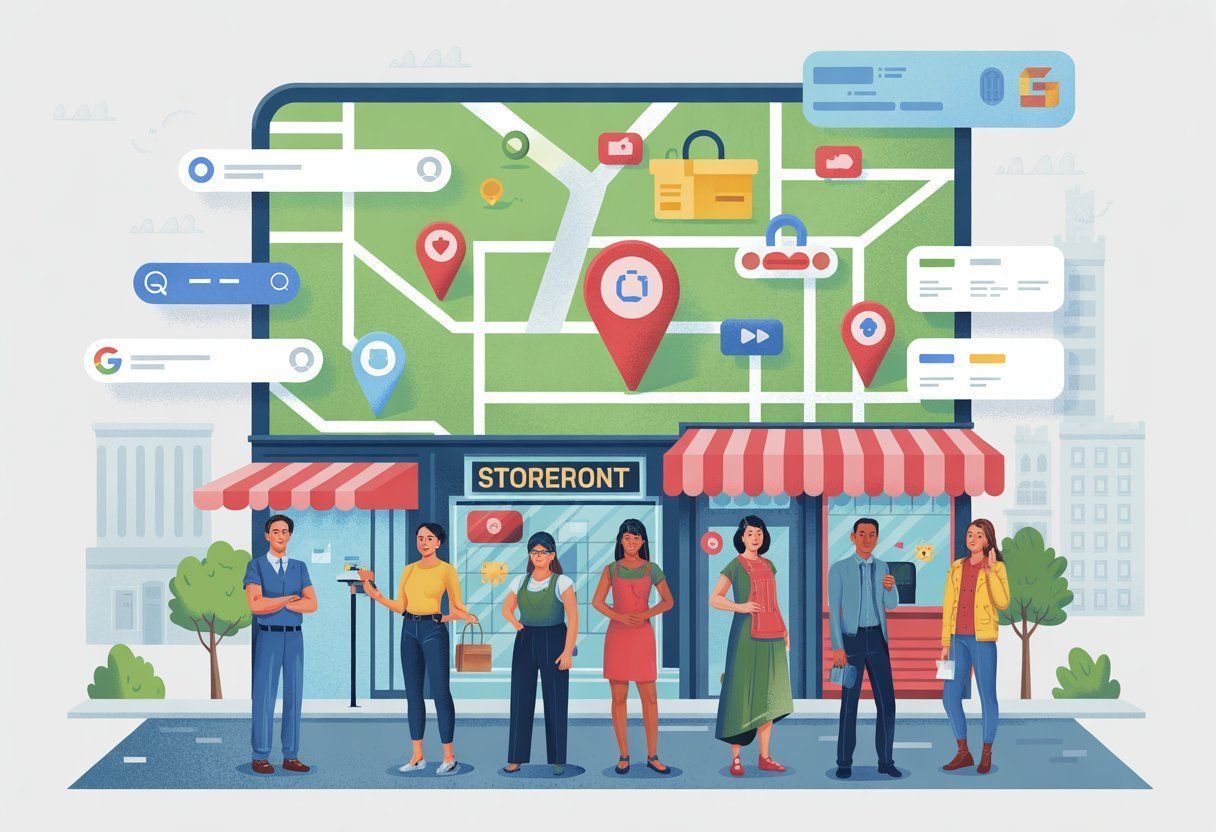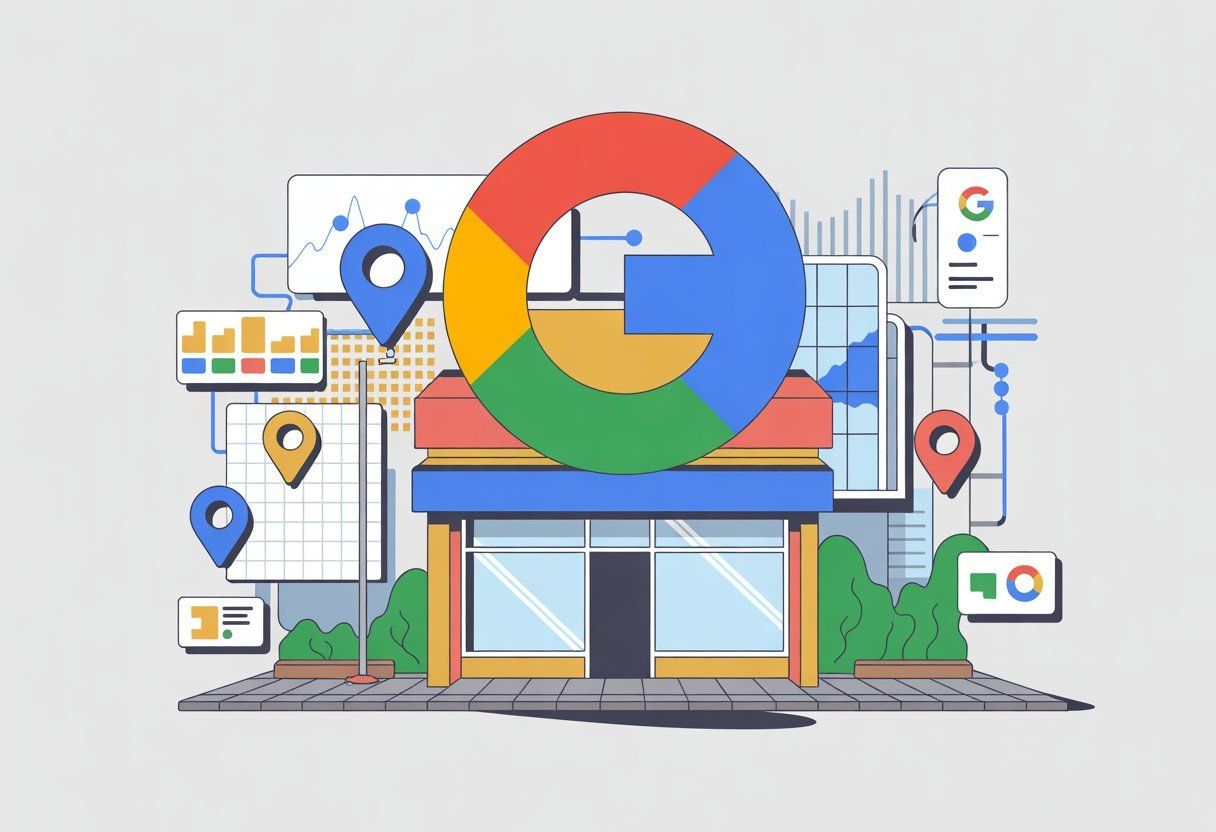SEO My Website Guru SEO Blog
By Frank Jones • November 4, 2025

When people search for businesses like yours nearby, you want to show up first. Local SEO puts your business on the map—literally and figuratively—so you appear in Google’s local results right when people are ready to buy.

You can master local SEO yourself. No need for expensive agencies or complicated tech skills.
Start by building a strong Google Business Profile , research the keywords your customers use, and make sure your business info matches everywhere online.
Local SEO helps you appear in search results when someone nearby searches for what you offer. It’s honestly one of the best ways to attract people who are already looking for what you do.
This guide walks you through every step, from the basics to more advanced stuff. You’ll learn how to optimize your presence, manage your reputation, build authority, and track your progress.
Whether you’re just starting out or tweaking what you’ve already got, these strategies can help you dominate local search in your area.
Understanding Local SEO and Its Impact
Local SEO helps businesses show up when people search for products or services nearby. It drives foot traffic, phone calls, and online conversions by connecting you with customers who are ready to buy in your area.
What Is Local Search and Local SEO?
Local search happens when someone looks for businesses close to them. People type things like "pizza near me" or "dentist in Chicago" into Google.
Local SEO means tweaking your online presence so you rank higher in these location-based searches. Local SEO helps you appear in search results when someone nearby searches for what you offer.
Search engines show local results in two main ways. The map pack displays three business listings at the top with a map.
Local organic results show up below as standard website links. That’s where you want to be.
Map Pack Features:
- Business name and address
- Phone number and hours
- Customer reviews and ratings
- Direct links to call or get directions
Local search intent is unique. If someone adds a location, they want fast, actionable results from businesses nearby.
Why Local SEO Matters for Local Businesses
76% of people who search for local businesses visit a store within 24 hours. That’s huge! Local SEO is a must-have for small business owners who rely on local customers.
Local SEO generates leads who already know what they want. Someone searching "emergency plumber" or "dentist open Saturday" is ready to book right now.
Key Benefits for Local Business:
- More foot traffic to your shop
- Extra phone calls and bookings
- Higher conversion rates than most marketing
- Stand out against big competitors
- Affordable way to get new customers
Small businesses can absolutely compete with bigger names in local search. A well-optimized local business often outranks national chains for location-specific searches.
Key Differences Between Local SEO and Organic SEO
Local SEO targets a specific region, while regular SEO chases a wider, more generic audience.
Local SEO zooms in on geographic relevance. You’ll optimize for terms like "Austin tax attorney" or "Denver coffee shop." Organic search goes after broader keywords without any location attached.
Ranking factors are different, too:
| Local SEO | Organic SEO |
|---|---|
| Google Business Profile optimization | Content quality and depth |
| NAP citations consistency | Backlink authority |
| Customer reviews and ratings | Technical site performance |
| Local keyword usage | Topical expertise |
| Geographic proximity | Domain authority |
Local SEO means keeping your business info accurate everywhere. Organic SEO is more about creating useful content that answers questions.
Search results look different, too. Local searches show map packs and location-based features. Organic search? You get the usual blue links and maybe some featured snippets.
Local businesses need both strategies. Local SEO grabs people nearby who need you now. Organic SEO builds long-term trust and catches people doing research.
Setting Up Your Local SEO Foundations
Success in local SEO starts with the right measurement tools, knowing where you stand, and understanding what actually drives local search rankings.
Establishing Tracking and Measurement Tools
Google Analytics is your go-to for tracking local SEO. Set up Google Analytics 4 on your site to watch where your traffic comes from and what people do.
Create goals for actions like phone calls, contact forms, and visits to your location page. These numbers show if local search traffic actually helps your business.
Google Search Console gives you the lowdown on your search performance. Add your site and verify it—HTML file upload or DNS verification works fine.
Check your search queries report to see which local terms bring visitors. Watch the impressions and clicks for location-based keywords.
Install Google Business Profile Insights to track how customers find your listing. It shows calls, direction requests, and website clicks straight from your Google listing.
Try tools like BrightLocal or Moz Local for more advanced tracking. They let you monitor rankings across different locations and keep tabs on competitors.
Set up weekly or monthly reports. Tracking over time helps you spot trends and adjust your approach fast.
Benchmarking Your Current Local Search Visibility
Google your business name plus your city to see where you rank. Check both regular results and the map pack.
Test on different devices and from different spots. Rankings change depending on where the searcher is and what they’re using.
Write down your current ranking for important local keywords. Search for things like "your service + your city" and see where you show up.
Use Google Search Console to check your average position for local terms. Look for keywords with location words or clear local intent.
Check your Google Business Profile completeness score. Incomplete profiles rarely make it to the top.
Take a look at your competitors, too. Search your main keywords and see which businesses land in the top three map pack spots.
Bing matters, too! Check your local visibility there. Set up a Bing Places for Business account to see where you stand.
Understanding Local SEO Ranking Factors
Google uses three main things for local rankings: relevance, distance, and prominence. Your business needs to match what people search for, be close to them, and have a solid online reputation.
Relevance means your info matches what people want. Your Google Business Profile categories and description should reflect your real services.
Distance is about how close you are to the searcher. You can’t move your shop, but you can optimize for nearby areas you serve.
Prominence is about how well-known you are online and offline. This includes your website’s authority, the number and quality of reviews, and local citations.
Reviews matter—a lot. Google looks at both how many reviews you have and your overall rating.
Citations are mentions of your business name, address, and phone number on the web. Keeping these consistent across directories helps Google trust your info.
Search volume for local terms is usually smaller than national keywords, but search intent is way stronger. Local searchers are ready to act.
Your website’s technical SEO affects local rankings, too. Page speed, mobile-friendliness, and structured data all play a part.
Local Keyword and Competitor Research
Local SEO works best when you find keywords that match how people actually search in your area—and when you know what your competitors are up to.
The right research uncovers valuable search terms and shows you where competitors are weak.
Conducting Effective Local Keyword Research
Start by brainstorming local keyword ideas that combine your services with locations. Imagine how your customers would look for you and jot down those phrases.
Primary keyword types to target:
- Service + City (plumber Chicago)
- Service + Neighborhood (dentist downtown Austin)
- Service + "Near me" (pizza near me)
- Problem-based queries (emergency locksmith)
Use Google’s autocomplete to grow your list. Type your service and location, then note every suggestion that pops up.
Google Keyword Planner gives you search volume if you set your location filter. Always filter by your city or region so you don’t waste time on national terms.
Free tools like Google Trends show which local searches are hot right now. It’s handy for spotting seasonal changes or new trends in your area.
Local keyword research tools help you find terms with buying intent, not just curiosity. Focus on keywords that show someone’s ready to hire or visit you.
Keep everything organized in a spreadsheet. Make columns for keyword, search volume, competition, and how relevant it is to your business.
Choosing the Right Local Keywords
Search volume matters, but local intent matters even more. A keyword with 100 monthly searches from people in your area usually beats 1,000 searches from folks outside your service zone.
Look for keywords with clear commercial intent. These are the terms your customers use when they’re ready to take action:
| High Intent | Medium Intent | Low Intent |
|---|---|---|
| "hire plumber" | "plumber reviews" | "plumbing tips" |
| "book appointment" | "best dentist" | "dental care guide" |
| "emergency repair" | "compare prices" | "how to fix" |
Target long-tail keywords that include your specific location. For example, "emergency plumber downtown Seattle" faces less competition than just "plumber Seattle."
Filter keywords by relevance: Cut out terms that don’t match your actual services. If you don’t offer 24/7 service, skip the "24 hour" keywords.
Search engines reward businesses that match user intent closely. Choose keywords where you can genuinely help the searcher.
Stick to 10-30 primary keywords instead of chasing hundreds. Focusing your efforts lets you create better content and actually track what’s working.
Evaluating Competitors in Local Search
Search your target keywords in Google Maps and regular search to spot your top 3-5 local competitors. These are the businesses that keep popping up in the local pack for your most important terms.
Analyze competitor Google Business Profiles:
- Categories they use
- Keywords in their descriptions
- Photo quality and quantity
- Review count and response rate
- Services and products listed
Use free tools like MozBar or just poke around manually to check out competitor websites. See which content topics they focus on and which keywords show up on their service pages.
Competitor analysis can reveal gaps in your own local SEO game. Notice what your competition does well—and where they totally drop the ball.
Check competitor citations by searching their business name plus "reviews" or "listings." This shows you which directories and review sites matter most in your market.
Document competitor findings:
- Which keywords they rank for that you don't
- Content topics they cover extensively
- Local directories where they have strong presence
- Weaknesses in their profiles or website content
Spotting these details helps you find opportunities to outrank them by targeting keywords they ignore or by simply doing a better job where they’re weak.
Optimizing Your Google Business Profile
Your Google Business Profile is basically your digital storefront on Google Search and Maps. Complete optimization is a must for local rankings.
Focus on accurate business info, strategic content posting , proper categories, and ways to engage people so you show up more often.
Completing and Verifying Business Information
Claim your Google Business Profile through Google My Business. Enter your exact business name as it appears on your signage and official docs.
Critical Information Elements:
- Business Name: Use your official registered name
- Address: Match your physical location exactly
- Phone Number: Use your main business line
- Website URL: Link to your main website
- Business Hours: Don’t forget special holiday hours
Verify your listing with the postcard method for max credibility. Google will send a code to your business address within a couple of weeks.
Keep your NAP (Name, Address, Phone) consistent everywhere online. Even small discrepancies can hurt your visibility in local search.
Upload a sharp logo and a cover photo that really represents your brand. The cover photo should clearly show your products, services, or storefront—don’t overthink it, just make it inviting.
Add a business description with relevant keywords, but keep it natural. Share what makes you unique and the specific services you offer to locals.
Leveraging Google Posts and Media
Google Posts show up right in your business profile and can boost engagement. Try posting something new at least once a week to keep your profile active and visible.
Effective Post Types:
- Product Updates: Show off new inventory or services
- Events: Promote special offers or local happenings
- News: Share updates or industry tidbits
- Offers: Add clear calls-to-action with deals
Upload high-quality photos regularly to keep your profile looking fresh. Show your products, team, interior, exterior, and even happy customers if they’re cool with it.
Short videos work really well on Google Business Profile. Post a quick clip of your business in action or explain a service in your own words.
Always use a clear call-to-action in every post. Phrases like "Call Now," "Visit Today," or "Book Online" can nudge folks to take the next step.
Check your post performance in Google Business Profile insights. See which types of content get the most attention and use that info to plan your next posts.
Selecting Categories and Attributes
Pick your primary category carefully—it really affects your local search rankings. Your main category should match your core business exactly.
Add up to 10 more categories that describe your services accurately. Strategic category selection helps you show up for related searches.
Category Selection Strategy:
- Research competitor categories with tools
- Go specific instead of general where you can
- Skip unrelated categories that might confuse Google
- Update categories when your services change
Add attributes to give more detail about your business. Include things like "wheelchair accessible," "outdoor seating," or "accepts credit cards."
Service attributes help people know what you offer before they visit. This can cut down on irrelevant calls and help you get better leads.
Update attributes when your features change or even seasonally. The more accurate you are, the better Google can match you with local searches.
Optimizing for Engagement and Click-Through Rates
Respond to all customer reviews quickly and with a friendly, professional tone. Your response rate and the quality of your replies really influence both rankings and trust.
Review Response Strategy:
- Thank people for positive reviews
- Address negative feedback constructively
- Work keywords in naturally
- Try to respond within 24-48 hours
Turn on messaging features so customers can reach out directly through your profile. Fast responses to messages can boost your engagement scores.
Use the Q\&A section to post common questions and detailed answers. Giving people info up front can improve your click-through rates.
Keep an eye on your Google Business Profile insights. Watch search queries, customer actions, and photo views to get a feel for how people interact with your listing.
Encourage reviews by following up with customers, adding reminders to receipts, or just asking in person. More recent reviews tell Google you’re active and open for business.
Building and Managing Local Citations

Local citations create the backbone of your local search presence. Getting your business info out there (accurately!) across the web helps search engines trust you more.
Consistency of NAP Across Directories
Your Name, Address, and Phone number have to match exactly on every listing. Search engines cross-check this info to confirm your business is legit.
Use the same business name everywhere. If you’re officially "Smith's Auto Repair LLC," don’t shorten it to "Smith's Auto" on some sites.
Keep your address format identical across platforms. Write "123 Main Street" the same way every time—don’t mix it up with "123 Main St." or "123 Main Street, Suite A."
Phone numbers need consistent formatting too. Pick either "(555) 123-4567" or "555-123-4567" and stick with it.
Create a master doc with your exact NAP info. Always copy and paste from it when submitting to local directories to avoid typos.
Common NAP mistakes to avoid:
- Using different business name variations
- Mixing abbreviated and full street names
- Inconsistent suite or unit numbers
- Different phone number formats
Submitting to Authoritative Local Directories
Start with Google My Business optimization. It’s free and shows up in Google search and Maps.
Submit to major directories next:
- Yelp- High authority consumer review platform
- Bing Places- Microsoft's business directory
- Facebook Business- Social media directory listing
Look for industry-specific directories for better relevance. Restaurants should get on TripAdvisor and OpenTable, while attorneys need Avvo and FindLaw.
List on your local chamber of commerce website for valuable local SEO citations. These community directories have strong local authority.
Priority directory submission order:
- Google My Business (essential)
- Major platforms (Yelp, Bing, Facebook)
- Industry-specific directories
- Local business associations
- Regional directories
Check where your competitors are listed—you might spot directories you’ve missed.
Addressing Inconsistent NAP Issues
Run citation audits regularly to catch inconsistent business info. Search your business name in quotes on Google to find what’s already out there.
Update incorrect listings as soon as you find them. Most directories let you claim and edit your profile directly.
If you can’t access a listing, contact directory support. Provide proof of ownership to speed things up.
Watch for duplicate listings that split your citation power. Ask to remove or merge duplicates if you spot them.
Steps to fix NAP inconsistencies:
- Document all current listings and their info
- Spot discrepancies in name, address, or phone
- Claim and update what you can
- Submit requests for locked profiles
- Remove or merge duplicate entries
Use citation management tools to track changes across platforms. These tools alert you when your directory listings get out of sync.
Set a monthly reminder to review your top 20 citations for accuracy. It takes a little time but saves headaches down the road.
Earning Trust with Local Reviews and Reputation Management

Your local search rankings depend a lot on customer reviews and how you handle your reputation online. Building a steady flow of positive reviews—and responding to all feedback—creates trust signals that Google notices when ranking local businesses.
Encouraging and Managing Online Reviews
Getting more reviews usually starts by asking customers at just the right moment. Ask for reviews right after finishing a service or making a sale—when people are happiest with you.
Send follow-up emails within a day or two and include direct links to your Google Business Profile review section. A simple message like "We'd love to hear about your experience with us" works wonders.
Review request methods that work:
- QR codes on receipts linking straight to review pages
- Text message follow-ups with review links
- In-person requests after a good interaction
- Email campaigns to past customers
Make leaving a review as easy as possible. Give customers direct links so they don't have to hunt for your page.
Local reputation management takes steady effort if you want a regular flow of fresh reviews.
Track which methods actually bring in reviews. Put more energy into the channels that get the best response from your customers.
Responding to Customer Feedback
Respond to every review within 24-48 hours. This shows you care, and Google pays attention to businesses that engage with reviewers.
For positive reviews, keep it short and personal. Thank the customer by name and mention something specific they shared.
Negative review response framework:
- Acknowledge- "Thank you for sharing your feedback"
- Apologize- "We're sorry this didn't meet your expectations"
- Act- "Please contact us at [phone] to discuss this further"
Don't argue or get defensive in public. If someone has a detailed complaint, give them a way to contact you privately and work it out offline.
Building trust through proper review management shows people you actually care about service and satisfaction.
Boosting Star Ratings and Local Reputation
Focus on making your service better overall, not just on getting more reviews. When you wow your customers, great reviews come naturally.
Check your average star rating every month. Most people won't even consider a business with less than 4.0 stars on Google.
Star rating improvement tactics:
- Address common complaints in negative reviews
- Train your team on customer service basics
- Follow up quickly on any service issues before people leave a review
- Run regular quality control checks
If you spot fake or spam reviews, report them to Google through your Business Profile dashboard. You can't remove real negative reviews, but a steady stream of positive ones will drown them out.
Reputation marketing strategies can turn customer feedback into an advantage that brings in more local traffic and sales.
Create simple systems to keep your reputation strong. Consistent review requests and professional replies build the kind of trust that leads to higher local rankings.
On-Page SEO and Local Content Optimization

Your website needs to be ready for local searches if you want to compete in your area. This means targeted landing pages, using location keywords, and following best practices so search engines know your local relevance.
Optimizing Landing Pages for Local SEO
Create a dedicated landing page for every service area you want to reach. Use specific local keywords like "plumber in Miami" or "dentist near downtown Seattle."
Give each page unique content that speaks to local needs. Sprinkle in your city, neighborhood, and any local landmarks where it makes sense.
Display your full NAP info (Name, Address, Phone) clearly on every landing page. Stick it in the header, footer, or contact area as text so search engines can actually read it.
Essential Landing Page Elements:
- Local keyword in the page title and H1 tag
- Service area map showing where you work
- Testimonials from local customers
- Local business schema markup
- Mobile-friendly layout for folks searching on their phones
Keep meta descriptions under 155 characters. Include your target location and main service, and use calls-to-action like "Call today for same-day service in [City]" to draw people in.
Consistent NAP data on every page helps search engines trust you.
Enhancing Content with Local Keywords
Use keyword tools to find local search terms with good volume and low competition. Focus on phrases that mix your services with the area you serve.
Think about different types of local search intent:
- Informational: "how to find a reliable contractor in Boston"
- Commercial: "best pizza restaurants downtown Portland"
- Transactional: "emergency plumber near me open now"
Work location-based keywords into your content naturally. Try to get your main local keyword in the first paragraph, some subheadings, and even image alt text if it fits.
Keyword Placement Strategy:
| Location | Example Usage |
|---|---|
| URL slug | /services/roofing-denver-colorado |
| Title tag | Emergency Roofing Repair Denver - 24/7 Service |
| H1 heading | Professional Roofing Services in Denver |
| Meta description | Denver's trusted roofing experts. Free estimates. |
Add content about local events, weather, building codes, or community issues relevant to your services. This shows you actually know your area.
Implementing On-Page SEO Best Practices
Speed matters. Optimize your page load times—mobile users won't wait around. Compress images and clean up your code.
Use clear headings (H1, H2, H3) with local keywords when it fits. Break up text with bullet points and keep paragraphs short so it's easy to scan.
Add local business schema markup so search engines can show your info in rich results. Include your address, phone, hours, and service areas in the structured data.
Technical Optimization Checklist:
- Mobile-responsive design for local searches on phones
- SSL certificate for trust and security
- Clean URLs with location keywords
- Images with local alt text
- Internal links between your location-specific pages
Keep an eye on your local SEO with tools that track your rankings for local searches. Use that data to tweak your on-page elements as needed.
Create sitemaps for each location and submit them to search engines. This helps crawlers map out your service areas and content.
Local Link Building and Backlink Strategies
Getting quality local backlinks from other businesses and organizations in your area tells search engines that your business is part of the community. These links boost your local search rankings and help build trust with Google and real people.
Acquiring Local Backlinks
Start by listing your business on big directories like Google Business Profile, Yelp, and your local chamber of commerce. These are your foundation for local citations.
Your Name, Address, and Phone Number (NAP) need to match exactly everywhere. If they're inconsistent, search engines get confused and your local SEO suffers.
Use competitor tools like Ahrefs or SEMrush to see where your competition gets backlinks. Export their lists and reach out to the same sites for your own opportunities.
Local media outlets are gold for backlinks if you can get news coverage. Pitch stories about your business, like:
- Community service projects
- Hiring announcements
- Industry reports with local data
- Grand openings
Contact local newspapers, radio, and blogs with interesting press releases. Focus on stories that help the community—not just self-promotion.
Partnering with Local Organizations
Sponsor local groups to build relationships and earn quality backlinks from respected community sources.
Find sponsorship opportunities with Google search operators like:
-
inurl:sponsors "your city name" -
intitle:sponsors "your city name" -
intext:sponsors "your city name"
Non-profits make great backlink partners because:
- They usually have high domain authority
- Sponsorships can be tax-deductible
- They keep sponsor pages up to date
Cross-promote with other local businesses that complement yours. A coffee shop and a bookstore could do joint promos. Make pages for your partners and ask them to do the same for you.
Colleges and schools offer scholarship pages with high-authority backlinks. Offer a small scholarship tied to your industry and ask local colleges to list it on their financial aid sites.
Leveraging Local Events and Sponsorships
Local events are packed with backlink opportunities—think event listings, speaker bios, and sponsor pages.
Event participation ideas:
- Speak at conferences or trade shows
- Host a workshop in your field
- Be a vendor at community festivals
- Run a charity drive or fundraiser
Event sites usually give speakers and sponsors a dedicated page with a link back to your business. These local link building tactics help show you're active in the community.
Award applications can get you backlinks from local media and business journals. Look for industry awards in your area using the same search tricks as sponsorships.
Or create your own award for other local businesses. For example, a plumber could give out a "Best Local Hardware Store" award each year—great for press and reciprocal links.
Share your community involvement on social media and your website. This kind of content often attracts natural backlinks from other businesses and bloggers who love a good local story.
Mobile Optimization and Voice Search Readiness
Over half of all local searches happen on mobile devices, so mobile optimization is non-negotiable for local SEO. Voice search optimization comes with its own technical quirks that are a bit different from the usual typed queries.
Ensuring Responsive Website Design
Your website should adapt smoothly to all screen sizes and devices. Responsive design lets your content, images, and navigation adjust based on what device someone’s using.
Test your site on a variety of devices—smartphones, tablets, desktops, you name it. Check how your contact info, business hours, and location details look on those tiny screens. Sometimes things get squished or disappear, which is never good.
Key responsive design elements:
- Flexible grid layouts that scale with screen size
- Images that resize automatically without losing quality
- Touch-friendly buttons and navigation menus
- Readable font sizes without zooming
Google now uses mobile-first indexing. It mainly looks at your mobile site for rankings. If your site isn’t responsive, your local search rankings will take a hit.
Try Google’s Mobile-Friendly Test tool to see if your site meets the mark. Fix any issues it finds, like tiny text or buttons that are too close together.
Optimizing for Mobile Local Searches
Mobile users are often in a hurry, searching for things like “pizza near me” or “urgent care open now.” Your site should load fast and show the essentials right away.
Critical mobile local elements:
- Click-to-call phone numbers for instant contact
- One-tap directions using Google Maps integration
- Prominent business hours visible without scrolling
- Location address formatted for easy copying
Page speed is huge on mobile. Compress your images, minimize code, and use browser caching. Aim for load times under three seconds—nobody likes waiting.
If you’ve got more than one business location, create a page for each. Give each page unique info about that spot—services, staff, maybe even a local story or two.
Mobile optimization enhances local SEO by making the experience better and capturing more mobile searchers.
Preparing for Voice Search
People use voice search differently. They ask full questions, like “What’s the best Italian restaurant near downtown?” instead of just typing a couple of words.
Focus on long-tail conversational keywords that sound like real speech. Create content that answers the most common questions about your business and industry.
Voice search optimization strategies:
- Write FAQ pages addressing customer questions
- Use question phrases like "what," "where," "when," and "how"
- Keep answers concise at 40-50 words for featured snippets
- Include local landmarks and neighborhood names
Break up your content with clear headings and short paragraphs. Voice assistants prefer answers that are easy to read out loud and get straight to the point.
Add schema markup so search engines can better understand your business info. Include details like hours, phone, address, and service areas in your structured data.
Ongoing SEO Audits and Performance Measurement
Regular audits keep your local SEO strategy sharp. Tracking performance shows what’s working and what needs a tweak.
Running Regular Local SEO Audits
Schedule local SEO audits every quarter to maintain your search rankings. In competitive markets or after major site changes, monthly audits make more sense.
Key audit areas include:
- Google Business Profile accuracy
- NAP consistency across directories
- Citation quality and quantity
- Review response rates
- Website technical health
Start each audit by checking your Google Business Profile. Make sure your business hours, contact info, and service descriptions are up to date.
Next, review your local citations. Outdated numbers or addresses can confuse search engines, so fix any mismatches right away.
Look at your review profiles on platforms like Google, Yelp, and Facebook. Track how quickly you respond and whether sentiment is shifting.
Tracking Performance with Analytics Tools
Google Analytics shows how local search traffic converts on your site. Set up goal tracking for phone calls, forms, and direction requests.
Create custom reports to monitor these local SEO metrics:
| Metric | Tool | Frequency |
|---|---|---|
| Local search rankings | BrightLocal or Whitespark | Weekly |
| Organic traffic by location | Google Analytics | Monthly |
| Google Business Profile views | Google Business Profile Insights | Weekly |
| Citation health score | Moz Local or BrightLocal | Monthly |
Local SEO tools like BrightLocal track your rankings for location-based keywords. Watch positions for terms like “dentist near me” or “pizza delivery [city name].”
Google Search Console shows which local queries bring people to your site. Filter by location to spot trends in different areas.
Set up automated reports for weekly ranking updates. It saves you time and keeps you in the loop if something suddenly changes.
Adapting Strategies Based on Results
Dive into your data every month to see what’s boosting local search visibility. Look for patterns—did a new tactic make your rankings jump?
If some location pages aren’t performing, add more local content or tighten up the technical side. Pages with high bounce rates might need a better mobile experience.
When rankings drop:
- See if new competitors popped up in local results
- Make sure your Google Business Profile is still active
- Check for citation or technical issues
- Look into recent algorithm updates
Double down on what’s working for your search ranking. If customer reviews help, ramp up your review requests.
Test new strategies in small batches. Try different Google Business Profile post schedules or local content topics for a month, then expand what works.
Adjust your keyword targets based on what people in your area are actually searching. Local trends change as new businesses open or close nearby.
Frequently Asked Questions
Local SEO takes a mix of strategies and tools to get real results. Here are some common questions about what works, what matters, and how to boost your local search visibility.
How Can SEO My Website Guru Help Me?
Let’s face it, navigating local SEO gets tricky fast. Professional consultants give you strategies tailored to your business location and industry.
SEO services run thorough audits of your online presence. They’ll spot gaps in your Google Business Profile and check for citation consistency across directories.
You’ll get customized keyword research that targets the local search terms your real customers use. This includes location-based modifiers and service phrases that actually bring in traffic.
Experts keep an eye on your local SEO, making adjustments and sending regular reports so you can see your rankings and visibility improve.
What are the essential steps to optimize a website for local SEO?
Start by finding local keywords that bring customers to your business. Use terms that combine your services and locations, like “dentist Chicago” or “plumber near me.”
Create a dedicated page for each area you serve. Make sure each page has unique content about that location—don’t just copy and tweak the same text.
Add structured data markup so search engines understand your business info. Include your name, address, phone, hours, and even geographic coordinates.
Embed Google Maps on your contact or about page. This helps reinforce your location signals and tells Google exactly where you are.
Keep your NAP citations consistent across every directory. Your name, address, and phone number should match everywhere your business appears online.
How does SEO impact a business, and what are its core functions?
Local SEO brings in steady leads from people actively searching for your services. When people search for local solutions, their need is specific and urgency is high.
You get traffic from the map pack, which shows up at the top and grabs most of the clicks. Those three listings are gold for local searches.
Organic results below the map pack also bring in qualified traffic. These visitors usually want to dig a little deeper before reaching out.
SEO builds your brand’s visibility in the community. When you show up for relevant searches, you start to look like the go-to business in your niche.
Revenue grows as more qualified prospects find you online. Local SEO targets people who are ready to buy—not just window shoppers.
What strategies are recommended for improving local SEO rankings?
Optimize your Google Business Profile —it’s your top local SEO asset. Fill out every section, including description, categories, services, and upload quality photos.
Ask for customer reviews consistently. The best time is right after a positive experience, when people are happiest to help out.
Respond to every review, especially negative ones. Quick, professional replies show you care and can even turn a bad situation around.
Target location-based keywords on your site’s key pages. Use them naturally in titles, headers, and content, but don’t overdo it.
Build local backlinks from community groups, local news, and business partners. These links tell search engines you’re relevant and connected locally.
What are some key factors that influence local search engine optimization?
Three main factors determine map pack rankings : relevance, distance, and prominence. Google looks at how well you match the search, how close you are, and your reputation.
Your Google Business Profile supplies most of the info Google uses for local rankings. Complete, accurate, and regularly updated profiles do better.
Review signals—quality, quantity, and recency—directly affect your local SEO. Businesses with strong ratings and fresh reviews usually rank higher.
Consistent citations across directories reinforce your legitimacy. If your NAP info is inconsistent, search engines get confused and your ranking drops.
On-page optimization with local keywords helps you show up in organic results under the map pack. Well-structured pages with local content pull in extra traffic.
How can businesses leverage SEO tools to enhance their online visibility?
Use Semrush’s Organic Research tool to check competitor keywords and spot local opportunities. Plug in their domains and see which local terms they’re ranking for.
Google’s own tools are super useful (and free). Google Trends shows seasonal patterns in local search for your industry.
Local keyword tools help validate search volume and competition for your target terms. Even keywords with 50-100 searches a month can make a difference in your area.
Google Business Profile insights reveal how people find and interact with your listing. Watch which queries bring you up, and adjust your profile as needed.
Schema markup generators help you build structured data code without needing to be a developer. These tools make sure your LocalBusiness schema is formatted correctly.
What role does content play in a successful local SEO campaign?
Content that targets local keywords helps you show up in organic search results below the map pack. You’ll want location-specific pages that speak directly to customer needs in each area you serve.
Your Google Business Profile description should feel natural and use relevant local keywords. Make sure it clearly explains your services, but don’t cram in too many keywords—just use the terms real customers actually search for.
Blog posts about local topics and community events send strong local relevance signals. Try writing about neighborhood-specific issues or trends in your industry that matter to your customers.
Service pages focused on location-specific queries help you reach people researching particular offerings. Including local testimonials and case studies can really boost your credibility with nearby prospects.
Make sure each location page has unique content. It’s tempting to copy and tweak, but honestly, writing from scratch for each city is the way to go if you want to avoid duplicate content headaches and reach more areas.

About the Author:
Frank is the founder of SEO My Website Guru, a local SEO agency specializing in Map Pack rankings and organic growth for service-based small businesses. Drawing on years of hands-on experience testing real campaigns, auditing sites, and tracking thousands of keywords, he focuses on what actually drives calls, leads, and revenue—not vanity metrics. Frank regularly documents processes, runs data-backed experiments, and uses transparent reporting so business owners always know what’s happening and why. His approach is simple: ethical, evidence-based SEO that’s built to earn trust and long-term results.
Insights to fuel your marketing business
Sign up to get industry insights, trends, and more in your inbox.
Contact Us
We will get back to you as soon as possible.
Please try again later.
SHARE THIS
Latest Posts









